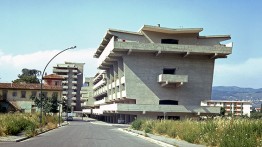Leonardo Ricci: Design Investigations on the Question of Dwelling
Fri, Apr 12, 2019 12pm - Fri, May 3, 2019 12pm

Tower House “La Nave” Sorgane, Florence 1962-1966
This exhibition explores the work of the Italian architect Leonardo Ricci (1918–1994). It focuses on his residential projects spanning a variety of scales, from single-family dwellings to communal and urban projects. Dating from 1946 to 1977, this work ranges from the architect’s own home and studio near Florence, Italy to his Dog Island community plan, a project that emerged from his speculative, global City-Earth project. This work reveals Ricci’s interests in stylized geometric shapes, his understanding of architecture in context of landscape, his vision of an original way of living, and his authentic sense of being in the world.
Of French-Swiss origin and Waldensian education, Leonardo Ricci was the second of four sons of Giuditta de Giorgi and Raniero Ricci, an engineer. Although he was influenced by his father's occupation, he showed a decisive early interest in painting which would become a profound root of his multiform cultural activity.
After moving from Rome to Turin, Ricci arrived in Venice and Padua where he had his first exhibition in his early twenties. In 1944 he opened a professional studio in Florence with fellow architects Leonardo Savioli and Giuseppe Giorgi Gori. Together they took part in competitions for the reconstruction of Florentine bridges and areas of the city center destroyed in WWII. In the debate against reconstructing Florence "as it was"—a position supported by Bernard Berenson—Ricci’s studio supported the thesis of Giovanni Michelucci, a Florentine architect and professor who saw the wounds of the city as new opportunities, places from which to start anew. The studio’s first important commission came in 1946 with the construction of the Waldensian village Agàpe, completed by John Klaus Koenig. During this time Ricci exhibited at the Salon de Mai with Pablo Picasso, Henri Matisse, and Alberto Giacometti and inaugurated a critically acclaimed solo exhibition at the Galerie Pierre. In the same years, Ricci began his teaching career at the University of Florence, first as an assistant and free lecturer, then as a professor and finally as headmaster. He fully participated in the protests of ‘68 until his resignation and exile to Venice in 1973. He was a charismatic teacher, passionate and open to criticism. Ricci also had the distinction of hiring Umberto Eco, who was called by Ricci to his first teaching position.
At the end of the 1950s Ricci designed organic-expressionist villas for high profile clients, such as the house for Elisabeth Mann Borgese in Forte dei Marmi (1957-59) and the house for the couturier Pierre Balmain on Elba Island (1958). His only industrial project was the multifunctional building of the Manifattura Goti in Campi Bisenzio, Florence (1959-62). In 1964 Ricci organized an exhibition of Expressionism at Palazzo Strozzi and in 1967 he was invited by Bruno Zevi, Giulio Carlo Argan, and Umberto Eco to design—in collaboration with Carlo Scarpa and Bruno Munari—a section of the Italian pavilion at the Montréal Expo. In 1977 he won a competition to design the Centro Direzionale Firenze; in 1978 he designed the Contreprojet pour les Halles in Paris; and in 1981 he designed the Chicago Herald Tribune skyscraper.
Third Floor Hallway Gallery—Foundation Building
This event is open to current Cooper Union Students, Faculty, and Staff.
View the full 2019 Spring Lectures and Events List.
Located at 7 East 7th Street, between Third and Fourth Avenues




